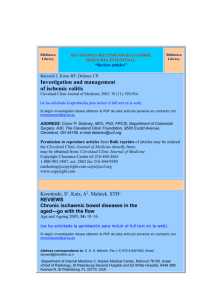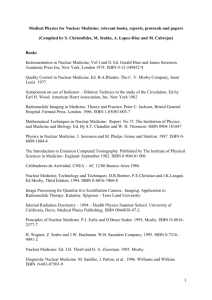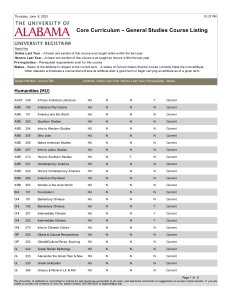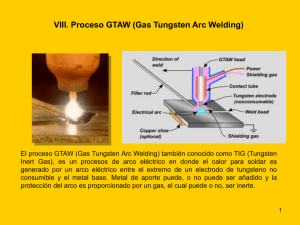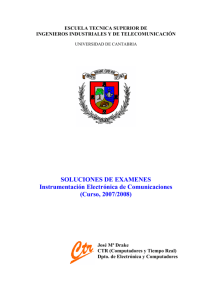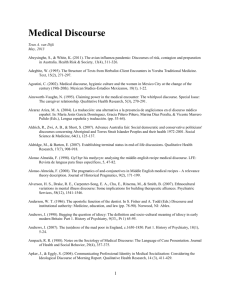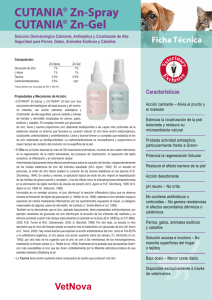Diarrea Secretora vs. Diarrea Osmótica
advertisement
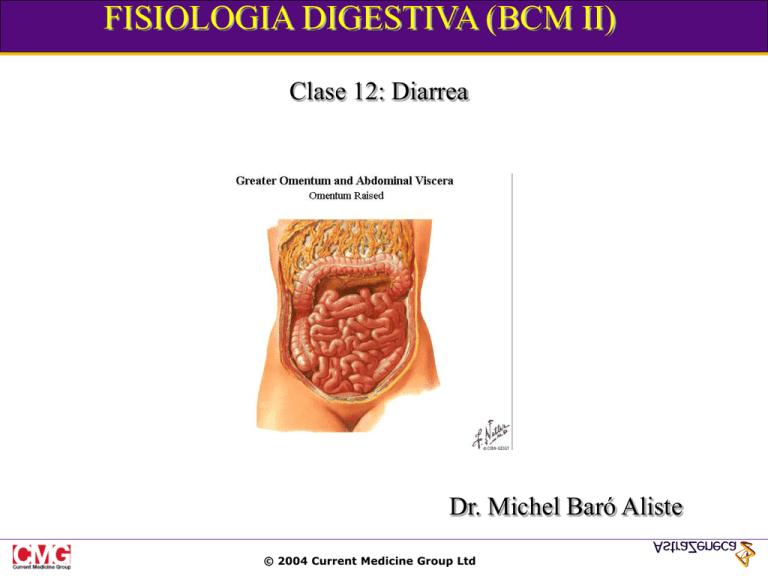
FISIOLOGIA DIGESTIVA (BCM II) Clase 12: Diarrea Dr. Michel Baró Aliste © 2004 Current Medicine Group Ltd Definiciones Diarrea: aumento de la frecuencia y/o volumen de las deposiciones Mayor a 200 g/día Pseudodiarrea Incontinencia Aguda (<2 semanas) Crónica (>4 semanas) © 2004 Current Medicine Group Ltd Tipos de Diarrea -Osmótica (malabsortivas) -Secretora (alteración de transporte de electrolitos) -Alteración de la motilidad -Inflamatoria (disenterías) © 2004 Current Medicine Group Ltd Water fluxes through the intestine © 2004 Current Medicine Group Ltd Calculation of osmotic gap Diarrea Secretora vs. Diarrea Osmótica © 2004 Current Medicine Group Ltd Typical features of secretory diarrhea TABLE 4 - 5. TYPICAL FEATURES OF SECRETORY DIARRHEA Voluminous, watery stools Little or no fecal osmotic gap, stool pH near 7.0 Usually persists during fasting Usually no pus, blood, or excess fat in stools © 2004 Current Medicine Group Ltd Effects of resection of different parts of small intestine (a) © 2004 Current Medicine Group Ltd Effects of resection of different parts of small intestine (b) © 2004 Current Medicine Group Ltd Effects of resection of different parts of small intestine (c) © 2004 Current Medicine Group Ltd Effects of resection of different parts of small intestine (d) Umbral catártico de las Sales biliares: 3 a 5 mmol/L © 2004 Current Medicine Group Ltd Effects of resection of different parts of small intestine (e) © 2004 Current Medicine Group Ltd Mechanisms of diarrhea in enteritis TABLE 4 - 10. MECHANISMS OF DIARRHEA IN ENTERITIS Decreased surface area (destruction or resection) Disrupted mucosal barrier (exudation) Decreased rate of absorption, caused by inflammatory mediators or enteric nervous system Diminished electrolyte absorption Increased electrolyte secretion Osmotic diarrhea due to malabsorption Carbohydrates Fatty acids, hydroxy - fatty acids Bile acid diarrhea © 2004 Current Medicine Group Ltd Bile acid malabsorption can be caused by various mechanisms (a) Diarrea secretora por Malabsorción de ac. biliares: Mecanismos: Tránsito aumentado Resección intestinal Daño mucosa del íleon Ac. biliares en colon > 3 mmol/l = diarrea © 2004 Current Medicine Group Ltd Laxatives and detection methods TABLE 4 - 15. LAXATIVES AND DETECTION METHODS Laxative Detection Method Phenolphthalein Alkalinization of stool produces pink color; spectrophotometry Bisacodyl Thin - layer chromatography Ipecac Thin - layer chromatography Senna Urinary assay for anthraquinone Magnesium Osmotic gap in stool water; increased concentration of magnesium in stool water Phosphate Increased concentration in stool water Sulfate Increased concentration in stool water Water Creation of factitious diarrhea by addition of water to stool specimen can be detected by measurement of low - stool osmolality (<< 290 mosm/kg) © 2004 Current Medicine Group Ltd Laxative abuse suspects TABLE 4 - 16. PATIENTS SUSPECTED OF LAXATIVE ABUSE Type Characteristics Patients with bulimia Usually adolescent to young adult women; concerned about weight or manifesting an eating disorder Secondary gain Ma y have disability claim pending; illness may induce concern or caring behavior in others Münchausen's syndrome Typically, a peripatetic patient who "enjoys" being a challenge to doctors; may undergo extensive testing repeatedly Polle syndrome (Münchausen by proxy) Dependent child poisoned by parent with laxatives to show how effective parent can be as a caregiver; may have history of sibling who died with chronic diarrhea © 2004 Current Medicine Group Ltd Diarrheal syndromes related to circulating secretagogues TABLE 4 - 17. DIARRHEAL SYNDROMES RELATED TO CIRCULATING SECRETAGOGUES Syndrome Typical Symptoms Main Mediators Zollinger - Ellison Pancreatic tumor, peptic ulcer, steatorrhea, diarrhea Gastrin Verner - Morrison Watery diarrhea, hypokalemia, achlorhydria, (pancreatic cholera) flushing Vasoactive intestinal polypeptide Medullary thyroid carcinoma Calcitonin, prostaglandins Thyroid mass, diarrhea, hypermotility Pheochromocytoma Adrenal mass, hypertension, diarrhea Vasoactive intestinal polypeptide, norepinephrine, epinephrine Carcinoid Diarrhea, flushing, wheezing, right - sided cardiac valvular disease Serotonin, kinins Somatostatinoma Nonketotic diabetes mellitus, steatorrhea, diarrhea, gallstones Somatostatin Glucagonoma Skin rash (migratory necrotizing erythema), mild Glucagon diabetes Hyperthyroidism Diarrhea, steatorrhea, weight loss, tremor Thyroxine, tri - iodothyronine Mastocytosis Flushing, dermatographism, nausea, vomiting, diarrhea, abdominal pain Histamine © 2004 Current Medicine Group Ltd Zollinger-Ellison syndrome results from secretion of gastrin © 2004 Current Medicine Group Ltd Vasoactive intestinal polypeptide-secreting tumors (a) Sindrome de Verner-Morrison o Cólera pancreático -diarrea acuosa -hipokalemia -hipocloridia © 2004 Current Medicine Group Ltd AMPc Vasoactive intestinal polypeptide-secreting tumors (b) VIPoma © 2004 Current Medicine Group Ltd Vasoactive intestinal polypeptide-secreting tumors (c) © 2004 Current Medicine Group Ltd Vasoactive intestinal polypeptide-secreting tumors (d) © 2004 Current Medicine Group Ltd Medullary carcinoma of the thyroid products © 2004 Current Medicine Group Ltd Drugs associated with diarrhea TABLE 4 - 29. DRUGS ASSOCIATED WITH DIARRHEA Antibiotics Hypocholesterolemic drugs Antineoplastic drugs Lovastatin Antiarrhythmics Gemfibrozil Quinidine Clofibrate Procainamide Probucol Antihypertensives Gastrointestinal drugs Beta - blockers Magnesium - containing antacids Angiotensin - converting enzyme inhibitors H2 - receptor antagonists Hydralazine Prostaglandin analogues (misoprostal) Antidepressants Sulfasalazine Lithium Olsalazine Fluoxetine (Prozac) Prokinetic drugs (cisapride) Tranquilizers Miscellaneous agents Alprazolam (Xanax) Methysergide Meprobamate Theophylline Anticonvulsants Diuretics Ethosuximide Oral hypoglycemic drugs Valproic acid Colchicine L - Dopa Thyroid hormone © 2004 Current Medicine Group Ltd Longstanding diabetes mellitus and chronic diarrhea © 2004 Current Medicine Group Ltd Malabsorción - Esteatorrea © 2004 Current Medicine Group Ltd Diseases that impair nutrient absorption Classification of Diseases that Cause Intestinal Malabsorption Premucosal Mucosal Postmucosal Pancreatic insufficiency Celiac sprue Congenital lymphangiectasia Hepatobiliary disease Tropical sprue Secondary lymphangiectasia Bacterial overgrowth Whipple's disease Rapid intestinal transit Eosinophilic enteritis Gastrectomy Brush border enzyme deficiency Lymphoma Short - bowel syndrome Prolonged malnutrition Radiation enteritis Parasitic infection Mesenteric ischemia © 2004 Current Medicine Group Ltd Stool fat concentrations as a clue to etiology 9,5% <6 g/día >20 g/día © 2004 Current Medicine Group Ltd Effect of oral pancreatic enzyme replacement (A) © 2004 Current Medicine Group Ltd Effect of oral pancreatic enzyme replacement (B) © 2004 Current Medicine Group Ltd Intraduodenal bile acid concentrations and fecal fat output 2,5 umol/mL Bilirrubina pl >4,5 mg% © 2004 Current Medicine Group Ltd Pathophysiology of bacterial overgrowth -Daño histológico -Malabsorción de nutrientes -Producción de toxinas Reabsorción en yeyuno Absorción grasa Inflamación Atrofia vellositaria © 2004 Current Medicine Group Ltd Multiple jejunal diverticula © 2004 Current Medicine Group Ltd Multiple small bowel diverticula © 2004 Current Medicine Group Ltd Scleroderma © 2004 Current Medicine Group Ltd Billroth I and II subtotal gastrectomy © 2004 Current Medicine Group Ltd Radiograph of a patient with a Billroth II procedure © 2004 Current Medicine Group Ltd Pathophysiology of lactase deficiency © 2004 Current Medicine Group Ltd Intestinal fluid accumulation with a lactose-containing meal © 2004 Current Medicine Group Ltd Effect of unabsorbed carbohydrate on stool water output 3,5 g H2O / mmol de molécula no absorbida (carbohidrato, ácido orgánico, catión) © 2004 Current Medicine Group Ltd Celiac sprue (A) – Enfermedad Celíaca Gluten: trigo, centeno, avena © 2004 Current Medicine Group Ltd Celiac sprue (B) Tres meses después de dieta libre de gluten © 2004 Current Medicine Group Ltd Molecular pathophysiology of celiac sprue (A) © 2004 Current Medicine Group Ltd Molecular pathophysiology of celiac sprue (B) © 2004 Current Medicine Group Ltd Molecular pathophysiology of celiac sprue (C) © 2004 Current Medicine Group Ltd Molecular pathophysiology of celiac sprue (D) HLA-DQ2 or HLA-DQ8 © 2004 Current Medicine Group Ltd Molecular pathophysiology of celiac sprue (E) © 2004 Current Medicine Group Ltd Molecular pathophysiology of celiac sprue (F) © 2004 Current Medicine Group Ltd Detecting celiac sprue (A) © 2004 Current Medicine Group Ltd Detecting celiac sprue (B) © 2004 Current Medicine Group Ltd Classic moulage pattern of celiac sprue © 2004 Current Medicine Group Ltd Tropical sprue © 2004 Current Medicine Group Ltd Whipple's disease © 2004 Current Medicine Group Ltd Eosinophilic gastroenteritis © 2004 Current Medicine Group Ltd Massive small-bowel resection Predicted Nutritional Outcome in Patients who ha ve had Massive Intestinal Resection Remaining Jejunal length, cm Colon Nutritional outcome 0 - 50 - TPN + TPN - IVFM/TPN + Modified oral diet - Regular or modified oral diet + Regular diet - Modified oral diet + Regular diet - or + Regular diet 51 - 100 101 - 150 151 - 200 >200 © 2004 Current Medicine Group Ltd Jejunal length and sodium-water absorption (A) © 2004 Current Medicine Group Ltd Jejunal length and sodium-water absorption (B) © 2004 Current Medicine Group Ltd Rehydration therapy enhances sodium and water absorption © 2004 Current Medicine Group Ltd Sodium balance after different sodium-containing test solutions © 2004 Current Medicine Group Ltd Oral rehydration therapy and high-volume ostomy output © 2004 Current Medicine Group Ltd Radiation enteritis © 2004 Current Medicine Group Ltd Lymphangiectasia © 2004 Current Medicine Group Ltd Selected symptoms and signs of nutrient deficiencies Selected Symptoms and Signs of Nutrient Deficiencies Symptoms or sign Possible nutrient deficiency General Weakness, weight loss, muscle wasting Protein, calorie Skin Pallor Folate, iron, vitamin B12 Follicular hyperkeratosis Vitamin A, vitamin C Perifollicular petechiae Vitamin C Dermatitis Protein, calorie, niacin, riboflavin, zinc, vitamin A, essential fatty acids Bruising, purpura Hair Eyes Mouth Easily plucked, alopecia Vitamin C, vitamin K Corkscrew hairs, coiled hair Protein, zinc, biotin Night blindness, keratomalacia, photophobia Vitamin C, vitamin A Conjunctival inflammation Vitamin A Glossitis Vitamin A, riboflavin Bleeding or receding gums, mouth ulcers Riboflavin, niacin, folate, vitamin B12, protein Decreased taste Vitamin A, vitamin C, vitamin K, folate Burning or sore mouth and tongue Zinc, vitamin A Angular stomatitis or cheilosis Vitamin B12, vitamin C, niacin, folate, iron Neurologic Tetany Riboflavin, niacin, pyridoxine, iron Paresthesias Calcium, magnesium Loss of reflexes, wrist drop, foot drop, loss of vibratory and position sense Thiamine, pyridoxine, vitamin B12, vitamin E Dementia, disorientation Niacin, vitamin B12 Ophthalmoplegia Vitamin E, thiamine Depression Biotin, folate, vitamin B12 © 2004 Current Medicine Group Ltd D-xylose to evaluate small-intestine absorptive function © 2004 Current Medicine Group Ltd Enfermedad Inflamatoria Intestinal •Colitis Ulcerosa •Enfermedad de Crohn © 2004 Current Medicine Group Ltd Endoscopic features of active ulcerative colitis (B) © 2004 Current Medicine Group Ltd Microscopic features of specimen in Fig 4-8 (B) © 2004 Current Medicine Group Ltd Endoscopic features of Crohn's disease (A) © 2004 Current Medicine Group Ltd Specimen from patient with Crohn's colitis (B) © 2004 Current Medicine Group Ltd Inflammatory bowel disease etiology TABLE 4 - 26. THEORIES OF INFLAMMATORY BOWEL DISEASE ETIOLOGY Toxic response to luminal contents Specific microbial pathogen Abnormal luminal constituents Increased absorption of luminal macromolecules Enhanced immunologic response to normal constituents Autoimmune response To epithelial cell or mucus glycoproteins Molecular mimicry (cross - reactivity of intestinal microflora and epithelia) To immune cells © 2004 Current Medicine Group Ltd Infliximab © 2004 Current Medicine Group Ltd © 2004 Current Medicine Group Ltd
